Van Gogh Museum Journal 1996
(1996)– [tijdschrift] Van Gogh Museum Journal–
[pagina 144]
| |
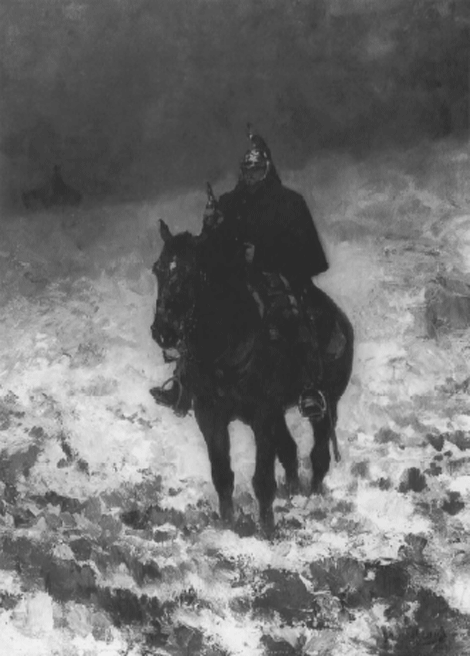 fig. 1
René Princeteau, A dragoon on watch on a snowy hillside, c. 1879-81, Amsterdam, Van Gogh Museum (on loan from The Hague, Rijksdienst Beeldende Kunst) | |
[pagina 145]
| |
René Princeteau's Dragoon and the depiction of the Franco-Prussian War
| |
Princeteau and Toulouse-LautrecUntil it was lent to the Van Gogh Museum in 1994, this painting hung in the stairwell of the Ministry of Defence in The Hague. The decision to borrow it from the Rijksdienst Beeldende Kunst was partly based on the fact that Princeteau was the teacher of Vincent van Gogh's friend Henri de Toulouse-Lautrec, and that the latter had made a copy of this very painting in 1881 (fig. 2).Ga naar voetnoot1 The older artist was in fact a good friend of the Lautrec family, as his Equestrian portrait of Comte Odon de Toulouse-Lautrec demonstrates (private collection).Ga naar voetnoot2 As is well known, Henri was a sickly child who was forced to spend long periods bed-ridden. Already in his early years he was attracted to horses, races and the hunt. He drew them continuously so that by the time he began his formal training he already had a large body of juvenilia on these subjects, works that reflected his aristocratic family's way of life in an intimate and naive manner. These themes had a long-standing tradition among the Anglophile French upper class, and so it was only natural that Toulouse-Lautrec would have sought to emulate painters like Princeteau, Edmond-Georges Grandjean, John-Lewis Brown, Georges de Busson, and Clement-Galleran when he took up painting in the late 1870s.Ga naar voetnoot3 | |
[pagina 146]
| |
 fig. 2
Henri de Toulouse-Lautrec, Cuirassier (d'après Princeteau), 1881, Japan, private collection 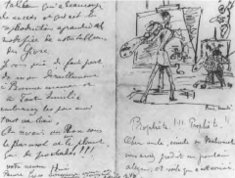 fig. 3
Caricature of Princeteau and Toulouse-Lautrec, 1881, Albi, Maison natale 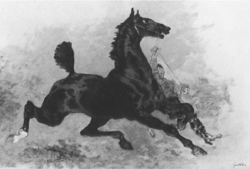 fig. 4
René Princeteau, Groom leading a stallion, 1875-77, private collection (photograph courtesy of Galerie Schmit, Paris) Given this and the family connection, Princeteau was an obvious choice as a first teacher. In addition, on a visit to Paris in 1875, Lautrec had seen and admired Princeteau's Washington,Ga naar voetnoot4 and his letters between 1879 and 1882 bear witness to his deep personal attachment to the artist, strengthened by their shared disabilities. He entered the studio in 1878, first informally and then regularly in 1881; he also spent several months there in 1882. Princeteau encouraged his pupil to further his studies with other masters, introducing him finally to Léon Bonnat.Ga naar voetnoot5 The two were apparently inseparable in these years, going to the Louvre to study the Spanish Old Masters, but especially to the races. One can easily imagine what an odd couple they formed, Princeteau tall and thin next to his much smaller and rounder companion. Lautrec himself parodied their affiliation, and also illustrated their enthusiasm for their art, in a caricature in a letter to his uncle, Charles de Toulouse-Lautrec (fig. 3).Ga naar voetnoot6 Beyond this, however, Princeteau was Lautrec's most important stylistic and thematic inspiration at this time. Although it would probably be going too far to attribute | |
[pagina 147]
| |
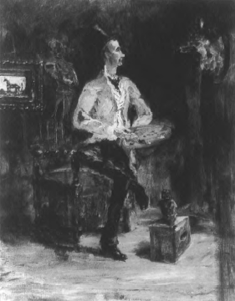 fig. 5
Henri de Toulouse-Lautrec, Portrait of Princeteau in his studio, 1881, private collection Lautrec's later flattened decorative style directly to works like Groom leading a stallion (fig. 4), the similarities are indeed striking. In 1881 he painted a portrait of Princeteau so like the older artist in feeling and facture that could almost have been a self-portrait (fig. 5).Ga naar voetnoot7 Princeteau wrote of his pupil: ‘Young Henri is working valiantly in my studio and making miraculous progress; he imitates me like a monkey.’Ga naar voetnoot8 He also referred to him as ‘son nourisson d'atelier,’Ga naar voetnoot9 a comment not only on the Lautrec's age (he was 14 when he joined Princeteau's studio) but also on their relationship. In addition to the subjects one would expect to find in a young artist aspiring to be a fashionable sporting painter, Lautrec also painted and drew a number of scenes of contemporary military manoeuvres as well as mounted guardsman (fig. 6).Ga naar voetnoot10 In May 1881, Henri's mother wrote that her son was busy copying a work by Princeteau.Ga naar voetnoot11 As no other exact copies are recorded, it is safe to assume that she is referring | |
[pagina 148]
| |
 fig. 6
Henri de Toulouse-Lautrec, drawing from the Album de jeunesse du comte Henri Toulouse Lautrec, Bern 1985 to the Dragoon. The work is signed with Lautrec's monogram and inscribed ‘d'après Princeteau,’ as well as dated ‘1881’. This would make it one of the first works he produced after officially entering the studio.Ga naar voetnoot12 It is in some ways a remarkable choice, as the older man's oeuvre offered any number of works which would have appealed to Lautrec's tastes and been even more suited (while more complex in composition) to such an exercise. It is possible that it was only recently completed and was therefore available in the studio. Or perhaps Lautrec, having already executed several pictures on military themes, was drawn to it for that reason. Already of a generation that was to demonstrate little interest in the Franco-Prussian War or the revanche, we must assume that the choice had such prosaic foundations and that it did not stem from an interest in the deeper meanings of the subject as discussed below. As would be expected in a copy, the young painter strove to imitate his master as closely as possible. Although more from inexperience than innate anti-academicism,Ga naar voetnoot13 Lautrec's version is (still) more awkward and abstract than his teacher's. Whether intentionally or not, the young painter has avoided most of the details, preferring instead to use the occasion to practice the scumbling technique he had so often admired and borrowed from Princeteau. Lautrec's enthusiasm for art, and particularly for Princeteau's art, is thus made palpable. The bond between the two men is given visible form in this homage and provides reason enough for a closer examination of Princeteau's life and oeuvre. | |
BiographyVery little has been written about the author of the Dragoon (fig. 1), probably best known as a painter of horses, the racetrack and hunting scenes.Ga naar voetnoot14 Except in connection with Toulouse-Lautrec his name is not one of those which has survived into the 20th century. A brief biographical sketch is therefore necessary, particularly since in many ways Princeteau's life, his upbringing and heritage, is the key to his work. René-Pierre-Charles Princeteau (1843-1914) was born in Libourne, in the Dordogne region.Ga naar voetnoot15 His father was a courtier en vins and the family belonged to the upper bourgeoisie of the Second Empire. Although a deaf-mute, René was given an excellent education and enjoyed all the privileges of a young man of his class and era. He visited Paris frequently, attending the openings of the annual Salon and the races. In general, one can say that from the earliest age he belonged to the fashionable elite of the period and this served him well in his later career. It provided him with subject matter that was appealing to both modernists and the more traditional, and made him a favourite among wealthy collectors. Although his behaviour sometimes appeared a bit strained and artificial due to his handicap, far from preventing him from entering Parisian society it in fact allowed him to view it from a very particular angle. He was simultaneously an insider and an outsider, and this position marked his vision of the world around him. Princeteau's talent for sculpture, drawing and painting were recognised early. He began his studies in sculpture in Bordeaux and in 1865, at the age of 22, he entered the Ecole Impériale des Beaux-Arts in Paris, where he worked in the studio of Augustin Dumont, famous for his decorations for Napoleon III's new Louvre. While still a student, | |
[pagina 149]
| |
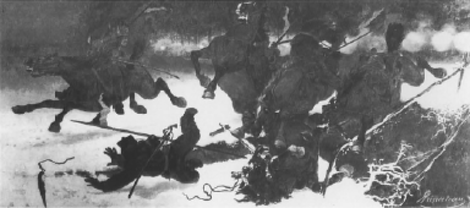 fig. 7
René Princeteau, Uhlan patrol ambushed by snipers, c. 1870-72, Libourne, Musée de Libourne Princeteau won two medals for composition. He began exhibiting at the Salon in 1868 (his first submission was an equestrian statuette entitled Pilote)Ga naar voetnoot16 and continued to take part in these exhibitions until 1902.Ga naar voetnoot17 The would-be sculptor soon turned to painting, beginning with academic historical and mythological subjects. Like many others of his generation, however, he eventually abandoned these themes and began to paint scenes from contemporary life in a more modern manner. Beginning in the 1870s, his particular interest became horses, always popular at the Salon, and a topic especially appropriate to a man of his background. Like Monet, Renoir and countless other painters of his age he spent the terrible year 1870-71 in London, where he probably encountered works by all the famous ‘sporting painters,’ particularly George Stubbs - pictures which certainly had a profound impact on his stylistic and thematic development. On his return to France, he became fascinated with the recent war. Unlike Edouard Detaille (1848-1912) and Alphonse de Neuville (1835-1885), the two most famous military painters of the early Third Republic, he had no personal experience of the events, and his interest arose from the stories he had read. His approach to the subject, as we shall see, was therefore a highly literary one. Already at the Salon of 1872 he exhibited Uhlan patrol ambushed by snipers (fig. 7). This was followed by a number of other works, discussed below, including the Van Gogh Museum's Dragoon. Interestingly enough, however, with one exception these later pictures were never shown at the Salon. In 1874, Princeteau opened a studio in the Rue du Faubourg Saint-Honoré, in the same grande impasse where John-Lewis Brown and Jean-Louis Forain also worked. All three artists dealt in similar themes and they probably influenced one another to some extent, as a work like Forain's Horsewoman (1882, Memphis, Tennessee, Dixon Gallery and Gardens) demonstrates. Princeteau soon had five students, among them Joseph Emanuel Verheyen (1851-1913), a self-styled Dutch baron and sculptor, and, somewhat later, Henri de Toulouse-Lautrec. | |
The oeuvreThe Bois de Boulogne and the racetracks were Princeteau's favourite haunts, and one of his greatest pleasures appears to have been hunting. These passions are reflected in his art; they are themes he took up in the mid- | |
[pagina 150]
| |
1870s and he remained true to them throughout his career. Like his subject matter, he developed his style early and it changed little in the course of his artistic life. It can best be described as both realist and expressive, almost to the point of Romanticism in some cases, combining the loose brushstroke and coloration of the Impressionists with subject matter that was both traditional and contemporary. Most of the artist's oeuvre consists of scenes that in some way involve horses: stables, races and the hunt, subjects with a long history and which were equally fashionable in both the Second Empire and the Third Republic. He also executed a number of equestrian portraits, of amazones, jockeys, the nobility, and military and political figures. The most important of these was of Marshal MacMahon, a veteran of the Franco-Prussian War and president of the Republic (fig. 8). For this highly official commission the artist changed his style drastically, exchanging his generally loose brushstroke for a facture reminiscent of the paintings of contemporary history created for the Galerie des Batailles at Versailles under Louis-Philippe.Ga naar voetnoot18 Probably along much the same stylistic lines is the mounted portrait of general Ducrot (1872, private collection), a man who had played an important role in a number of battles during the siege of Paris.Ga naar voetnoot19 In the later 1870s and early 80s he also painted a Portrait of George Washington (1875) for the American Embassy in Paris,Ga naar voetnoot20 as well as one of Jules Tardiveau (private collection), and a certain colonel Chabrol (private collection), both military figures of the day.Ga naar voetnoot21 | |
Sources and inspirationIn order to better characterise Princeteau's approach to this subject matter, it is perhaps useful to compare his works with those of his predecessors in the horse- related genre, namely George Stubbs, Eugène Delacroix, and, of course, Théodore Géricault. Despite his seeming modernity, Princeteau's influences came mostly from these artists of the past, and his highly expressive brand of Realism/Impressionism was very much indebted to the Romantic tradition. In his own period, however, his works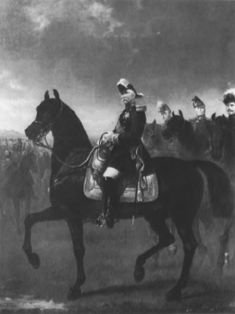 fig. 8
René Princeteau, Portrait of Marshal MacMahon, 1873-74, private collection (photograph courtesy of Galerie Schmit, Paris) can best be examined in relation to those of Edgar Degas. At the Salon of 1875 Princeteau exhibited Horses frightened by a passing train (private collection),Ga naar voetnoot22 a work based on an incident he had observed in the company of Toulouse-Lautrec.Ga naar voetnoot23 Although the actual event had involved work-horses, Princeteau replaced them with riding horses in the finished work, a change which made the whole more strongly reminiscent of such works as Horse frightened by a lion (1770, Liverpool, Walker Art Gallery) and Horse attacked by a lion (1762-65, London, Tate | |
[pagina 151]
| |
Gallery) by George Stubbs, or even Carle Vernet's Horses frightened by a storm (Musée d'Avignon). The Frenchman's hunting scenes, too, recall those of Stubbs, but are considerably more lively and realistic. Like Stubbs, Princeteau also made numerous ‘portraits’ of horses, some of them commissions.Ga naar voetnoot24 In contrast to the British painter, however, these are generally much less formal and stylised. The animals do not appear to be posing, but are rather depicted in natural positions. They are, however, sometimes placed against abstract, brushy backgrounds, calling to mind Stubbs's famous Whistlejacket (London, Kenwood House). Once again, however, Stubbs's animal seems aware of the viewer's gaze (in fact, it almost seems to be trying to seduce the onlooker), whereas Princeteau's exist for themselves. His individual horses are not mere objects or possessions, but rather something living and independent. Although in some ways his brushstroke can be said to resemble that of Delacroix, Princeteau was never interested in the exotic. His horses and riders are not Arabs on fiery steeds, as in Delacroix's famous Massacre at Scio of 1824 (Paris, Musée du Louvre), but modern Frenchmen pursuing the pleasures of the hunt, as, for example in The jump (Bordeaux, Musée des Beaux-Arts) or Hunters in action (Musée d'Albi). Nor was he particularly concerned with expressing the violent nature of his animals, as was the great Romantic in a work such as Arabian horses fighting in a stable (Paris, Musée d'Orsay). And he certainly would never have considered depicting horses in the throes of death or as mere corpses, as Delacroix did in a stirring painting in the Museum Mesdag in The Hague (Evening of the Battle of Waterloo, 1825). Princeteau's horses are peaceable creatures (fig. 9), well-trained - one might even say as civilised as their owners - saving their energy for the racecourse or the hunt. In the case of Géricault, there are a number of stylistic and thematic parallels, although again the overall mood of the works is quite different. Both artists sought to depict the grace that is a natural and essential part of the animal, accompanying it like a shadow through all its daily activities. Both artists were also fascinated by the specifics of anatomy and its expressive posibilities, as a comparison between works like Géricault's (in)famous Croupes (private collection) and Princeteau's Horse in a stable (from behind) fig. 9
René Princeteau, Three horses, 1870-72, private collection (photograph courtesy of Galerie Schmit, Paris) (private collection) demonstrates,Ga naar voetnoot25 or between the older artist's Grey horse (Musée de Rouen) and a depiction of the same type by Princeteau.Ga naar voetnoot26 It was the horse in its environment that interested both artists and the animal as something eminently alive, with a very particular kind of sensibility. However, although both made what can best be described as ‘horse-portraits,’ Princeteau's never have the sense of mystery or even unheimlichkeit that one finds so often in Géricault (fig. 10). For Géricault, the horse had more than a material reality: it was both a symbol of primordial energy and something almost fantastical.Ga naar voetnoot27 These aspects are paticularly well demonstrated by the various versions of his Course de chevaux libres and, especially, the so-called Derby d'Epsom (Paris, Musée du Louvre). It is even true of his depictions of working horses, a subject in which Princeteau was not in the least interested. For him, horses were something straightforward and directly beautiful. A race or a hunt were simply that and not the expression of psychological and social turmoil as they were for Géricault. Edgar Degas and the Impressionists were all contemporaries of Princeteau's. In addition, he and Degas had similar backgrounds and thematic interests. Their approaches to the subject of the racetrack could not, however, | |
[pagina 152]
| |
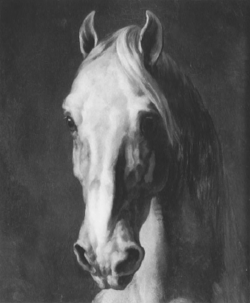 fig. 10
Théodore Géricault, Head of a white horse, n.d., Paris, Musée du Louvre have been more different. Whereas Degas's works tend to focus on the social aspects and marginal (though tense) moments of the event, as, for example, in At the races in the country (Boston, Museum of Fine Arts) or Before the races (Washington, D.C., National Gallery of Art), Princeteau's fascination was with the horses and the race itself. The crowds who gathered at Longchamps and elsewhere never appear in his paintings, the way they do in works such as Degas's Racehorses before the stands (Paris, Musée d'Orsay) or Manet's Race at Longchamps (The Art Institute of Chicago). Even at their fastest and most powerful, as in The finish of the Prix du Jockey-Club at Chantilly, 29 May 1892 (private collection) or The steeplechase (private collection),Ga naar voetnoot28 Princeteau's horses and riders remain distinct and clearly recognisable in a way that would have been foreign to ‘true’ Impressionists like Degas or Manet. His animals are not what Robert Herbert has referred to as ‘mobile stock coupons,’ ‘embodiments of industrial capital's drive for productivity and speed,’Ga naar voetnoot29 but rather belong to an older, more conservative - both stylistically and ideologically - world: that of the landed gentry of the Second Empire. In many ways more comparable is Renoir's A morning ride in the Bois de Boulogne (Hamburger Kunsthalle): one finds the same tone and even a similar style in paintings by Princeteau such as Madame Jean Fourcaud-Laussac en amazone (Musée de Libourne) or the Equestrian portrait of François de Cossé, the eleventh duke of Brissac (private collection).Ga naar voetnoot30 Considering the realistic, spontaneous, and even snapshot-like nature of Princeteau's images, the question arises as to his relationship to and use of photography. His | |
[pagina 153]
| |
non-official portraits, for example of jockeys,Ga naar voetnoot31 certainly have a photographic precision, but are also somewhat distorted to emphasise the character of the sitters. The artist was certainly well aware of the research of photographers like Muybridge; for the sake of expression, however, in many cases he preferred to follow his own sensibilities. One such example is The finish of the Prix du Jockey-Club. At a date when one already knew how a horse's legs really moved, he employed Géricault's famous gallop volant from the Derby d'Epsom. The painting can thus be seen as both an homage to Géricault and an indication of the artist's independence, his desire to capture the energy and speed of movement in a subjective way.Ga naar voetnoot32 This, too, may be an sign of his innate conservatism: the artist was willing to be modern, but only up to a point; he refused to accept art as a form of science. Likewise, he employed an impressionist technique, but was reluctant to go the final step that would have led to a disintegration of form. Accepting these two aspects would have meant embracing modernity in a way that would certainly have gone against his ingrained class attitudes. Clearly, this type of subject matter executed in this style meant that his patrons were mostly of the upper bourgeoisie and nobility - that is, the class to which he himself belonged. Many of his commissions were to paint the racehorses of dukes, counts and barons, and he is known to have gone hunting with the likes of the princes of Orléans and the duc d'Aumale. Considering this, and the generally uncomplicated nature of his works, their cheerfulness, energy, sense of well-being and material satisfaction, their richness, both literally (brushwork, thick paint) and figuratively, it is all the more surprising that he devoted a considerable amount of attention to depicting the darkest chapter of recent French history, namely the Franco-Prussian War. | |
Picturing the defeatFor the art historian interested in French painting of the late 19th century, it is surprising (and even puzzling) to discover that episodes from the Franco-Prussian War were among the most frequent subjects found in the paintings exhibited at the annual Salon. It appears that despite the fact that the defeat of Napoleon III's army at Sedan and the capitulation of Paris were not only political, but also deeply psychological traumas for the French nation, the attempts to artistically analyse the events of 1870-71 were extremely numerous. Nonetheless, there has been little interest in these pictures in the past and they remain to a large extent unknown.Ga naar voetnoot33 Faced with these images, a number of questions arise. In the first place, it is important to ask in which ways they might be considered perfectly suited to both the political and artistic conditions of the Third Republic. What was the interpretation of contemporary history they encouraged, and what did these works, in their pictorial analysis of events shameful in themselves, provide? What was their function in the mental and political economy of a defeated people? What were the visual means used to establish a certain interpretation of 1870-71 - an interpretation which was to help France out of the internal and external crisis caused by the defeat? It is within this general context that the paintings by Princeteau, including the canvas in the Van Gogh Museum, should be seen.
The Franco-Prussian War can be divided into two phases: the Imperial, with its famous battles of Froeschwiller, Rezonville, Gravelotte, and Saint-Privat, leading up to the defeat on 1 September at Sedan; and the Republican, led by Gambetta and the Government of National Defence, which continued on several fronts throughout the winter, most | |
[pagina 154]
| |
importantly around the besieged capital.Ga naar voetnoot34 The Napoleonic forces had been decimated by the fighting of July and August and little remained for the government but to create a new army, practically from scratch. Gambetta, hoping for a rebirth of the spirit of 1793, placed all his hopes in a ‘nation in arms.’ These men - young, untrained, ill-clothed and ill-equipped - did manage, with the help of such unorthodox figures as the famous franc-tireurs (snipers), to stave off a final defeat for nearly five months. This phase of the war, ‘la guerre à l'outrance,’ as Gambetta called it, was of no use to anyone and the losses suffered here only made the capitulation in January all the more bitter. Napoleon and his officers, many of whom had gained their positions through personal friendship with the Imperial couple, were generally given the blame for the defeat and not the common soldier, of whose individual bravery there was never, especially after the war, any doubt. Given these facts, one is forced to ask why images of a war which had ended in such deep humiliation were desirable at all? The answer lies in the inexorable connection of the defeat at Sedan with the birth of the Third Republic. It was this connection which made the paintings not only possible but even necessary, and it informs the vision of the war found in the works from beginning to end. As Miriam Levin has pointed out, the Republicans were strong believers in the power of art to communicate ideas: painting, sculpture, and architecture were a means of both expressing Republican values and of encouraging them in the viewer.Ga naar voetnoot35 Thus, even images of a lost war, if properly presented, could serve in the struggle for a new France, unified, strong and prepared for action. Because of the inseparability of the events of 1870-71 and the new political order, it is obvious that a critical representation of the war would not have been possible. Using the three things all Frenchmen had in common (the war, the defeat and the desire for revenge), this art aimed instead to propagate the Republican definition of French society, one in which all classes and groups were reconciled. It was also designed to aid in the formation a nation devoted to a strong military, which was seen as the guarantee of future security and power. Above all, it was to train the next generation to Republican beliefs and the idea of the revanche. It was therefore indispensable that the painted version of the events be a positive one, one which showed that France was great even in defeat, and that with the help of the Republic and all its citizens a revenge could be had that would make it greater still. The banner under which this was to be achieved was called gloria victis, and was given visual form in Antonin Mercié's sculpture of the same name (Paris, Musée d'Orsay). The question facing the painters of the Franco-Prussian war was: what could be depicted and how? The first difficulty to overcome was the changed nature of combat. By the time of the Franco-Prussian War, battles were being fought in an entirely new way. The battlefield could now be anywhere; modern weapons were extremely powerful and of long range; the enemy was not always visible and direct contact was rare. War was no longer about enthusiasm, bravery or personal heroism, but rather about tactics, weaponry, and strategic positions. The individual soldier was unknown to his commanders and even to his comrades; he was in a sense invisible, disappearing in the smoke of forceful artillery.Ga naar voetnoot36 In reality, he fought and died alone. This kind of warfare, however, could not be represented and exploited, and was therefore unfit for propaganda purposes. If this art was to function at all it had to appeal to the individual man, to give him something to identify with; without this, the purpose of his sacrifice would remain obscure. Thus, the soldier in these works is anything but anonymous, and even if he stands alone he stands for something. The painters' second problem was the changes that had occurred in both history painting itself and its reception during the course of the century. In the Third Republic, the audience for art was a very different one than it had been, and these new viewers, schooled in the immediacy and realism of popular media, were not interested in allegories and grandes machines. In order to appeal to them, it was necessary to cater to their taste for the narrative and the incidental. Yet, although it was desirable that the works should give the impression of actuality, it was equally important that they not fall into banality: they could not be mere chronicles but had to communicate a message, as grand style painting had once done. | |
[pagina 155]
| |
In spite of the fact that modern warfare was incompatible with these aims, it was necessary to develop a form that was both pictorial and that still seemed to make no concessions in matters of truthfulness. Above all, if the paintings were to serve the Republican cause, the audience had to be able to recognise itself in them. In short, events had to be emotionalised and yet seem true. Only in this way could the paintings achieve their aim. The artists of 1870 overcame the formal and ideological difficulties presented by both the war and the state of history painting by focusing not on great battle scenes but on the narrative ‘episode.’Ga naar voetnoot37 As Charles Baudelaire had written already in the 1850s, ‘a real battle is not a picture [...] a military picture will only be intelligible and interesting on the condition that it is a simple episode of military life.’Ga naar voetnoot38 Although the visual imagery of the Franco-Prussian War does not lack its fill of ‘traditional’ battle scenes, these types of images are in the minority. There are also relatively few allegorical or symbolical works - exceptions being, of course, the two works by Puvis de Chavannes in the Musée d'Orsay in Paris, The pigeon and The balloon. As would be expected in a Republican art, the high-ranking officer, observing and directing the battle - as, for example, in Ernest Meissonier's Napoleon III at Solferino (Paris, Musée d'Orsay) - rarely appears. The true hero of the Franco-Prussian War was the common soldier. It is his ‘portrait’ and actions that appear most frequently in the paintings, particularly those depicting the Republican phase of the war in the autumn and winter of 1870-71. The concept of the soldier which gained such popularity with painters and public alike was developed in Alphonse de Neuville's The last cartridges (fig. 11), exhibited at the Salon of 1873. Here, all elements of the French army and the French nation are brought together to face the enemy. They are anonymous, simple soldiers and, at the same time - as the revanchist author Paul de Saint-Victoire wrote - the incarnation of la Patrie. For him (and others as well) they were ‘Duty,’ ‘Resolution,’ and ‘Bravery’ incarnate.Ga naar voetnoot39 These men had sacrificed themselves for their country; the fact that they had fought and lost only made them all the more patriotic, all the more imitable. Contemporary critics saw The last cartridges not as mere genre but as history painting. It was not only a document, it also communicated a message, one which was to save and restore the French nation. As A. de Pontmartin wrote: ‘I boldly add that it [the painting] has a moral value; it counteracts against the feelings of humiliation, discouragement and sterile rage that a nation like ours has difficulty in resisting in disaccustoming itself to victory. M. Deneuville's [...] little group embodies the words of François I: HONOUR IS SAVED!, echoing from Reichshoffen to Gravelotte, from Wissembourg to Pataye and from Coulmiers to Villersexel.’Ga naar voetnoot40 Next to his willingness to fight even in desperate situations, the painters of 1870 emphasised the warrior élan with which the French soldiers sought to protect their country against the invader. This aspect is illustrated by innumerable scenes by artists such as Paul Boutigny, Paul Grolleron, Eugène Berne-Bellecour and many others of the defence of Paris and its environs. In this same spirit are the works representing guerilla warfare, such as the destruction of railway lines, the ambush or any other of the activities of the much mythologised franc-tireurs. The ‘defence of Paris’ works make up a large number of the total of all the those representing the war, and generally have titles such as Charge!, To your weapons or The last effort which underline the energy with which the French soldier faced every new challenge. Generally, only a few figures are placed together on the canvas so that each one becomes important as an individual, an effect underlined by the exactitude of the representation in terms of physiognomy and dress. Further, the artists sought to capture a precise moment of the action in all its contingency without, however, abandoning a sense of drama through the use of rhetorical gestures and expressions. In this way, | |
[pagina 156]
| |
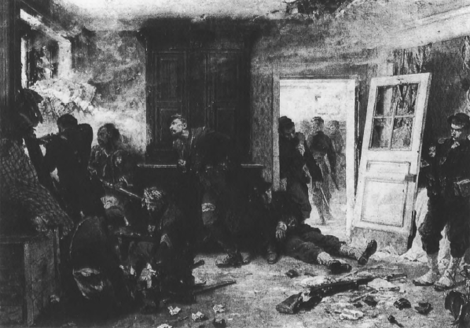 fig. 11
Alphonse de Neuville, The last cartridges, 1873, Bazeilles, Maison de la Dernière Cartouche | |
[pagina 157]
| |
the viewer was able to recognise himself in his compatriots, was made to feel physically part of the action and thus came to be convinced not only of their bravery but of his own duty to do as they had done in the future. And what of the enemy? Very often he is simply invisible, or, if present at all, then generally through the form of gun-smoke. One of the most famous examples is Detaille's Charge du 9e cuirassiers, à Morsbronn (Salon of 1874; Rheims, Musée Saint Rémi). It is left up to the public's imagination to make its own picture of the (enormous) odds the men of 1870 faced, a strategy that draws the viewer into the battle, making him play an active role and increasing his belief in the truth of what he is being shown. The reaction of the French public to these paintings was overwhelmingly positive and had an intensely emotional character often described in the criticism. In 1873, for example, an entire pamphlet was published containing selections from the Salon criticism praising Neuville's Last cartridges in the highest patriotic tones (see above). Emile Zola, in his Salon review of 1875, claimed this artist's Fire attack on a barricaded house (Paris, Musée d'Orsay) caused women to burst into tears and men to ball their fists in rage,Ga naar voetnoot41 and in 1876 he described a work by Detaille: ‘The whole scene vibrates with emotion, a kind of fierce and anguished silence.’Ga naar voetnoot42 Similar reactions were to be found to the works of other artists, most particularly in the writings of Jules Richard, who from 1886 to 1888 published the lavishly illustrated Salon militaire, devoted almost entirely to the art of 1870. What made these paintings so effective was not their subject matter alone, but rather the subject matter presented as reality. It has often been stated that the Third Republic's preferred style was realism. Having said this, however, the concept must be defined more closely. The type of realism the regime supported was neither that of Courbet nor that of the Impressionists. Recalling the Republicans' belief in the power of art to communicate ideas, and their need to speak to a large audience, it becomes clear that the type of realism they would have supported would have been one that presented the facts clearly and legibly, and yet also communicated a higher meaning. Their ideal of history painting was a form that presented both the reality of an event and its interpretation simultaneously: works which focused on the spectacular and momentary, which suggested the presence of the eye-witness account and yet at the same time conveyed the kind of message only an invented image was capable of transmitting. The artists of 1870 sought to meet the challenge of the popular image and to create something easily consumable without, however, sacrificing art's ability to deliver a political message in the older tradition of history painting. Although the explanations for the debacle of 1870-71 ranged from the idea of a godly punishment to the decadence of the Latin race in general to a purely political interpretation which blamed everything on Napoleon III, we do not find any of these reflected in the art produced during the next three decades. Instead, the painters closed ranks with the novelists and chauvinistic patriots, who sought to propagate the idea that the defeat was brought about by the barbarity of the Germans and their unorthodox methods and that the French soldier - brave, individualistic, fighting to the last full of warrior élan - had been simply crushed by this invading mechanical mass from the east: in other words, gloria victis. This idea of the soldier of 1870-71 may be said to represent the Republican interpretation of the war: since the individual Frenchman fought so bravely, nothing had actually been lost - in fact, everything had been gained, namely a new form of government. Behind all these images stands the idea of the unity of the nation, that all Frenchmen, regardless of age, class, political or religious beliefs or even colour, fought together against the enemy. Aside from demonstrating this unity in a time of war, these works sought to encourage its continuation in the present. The aim of this art, like that of the popular novels it so resembled, was to enrage the viewer, to move him, to restore his belief in the French nation and, especially, to prepare him for the revanche. | |
Princeteau's ‘militaires’Although his scenes of the Franco-Prussian War do not make up a major part of his oeuvre, Princeteau's interest in the military and his involvement with other painters devoted to creating such images makes his interpretation an interesting one. Having collaborated with Neuville on two major projects - the panoramas of the battles of Champigny and Reichshoffen (both exhibited in 1878), for which he painted the horses - he was well aware of the importance of these images for a recovering France. | |
[pagina 158]
| |
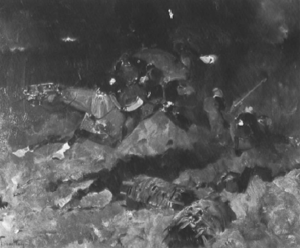 fig. 12
René Princeteau, The wounded cavalryman, c. 1870-71, Libourne, Musée de Libourne (legs Robin) Not surprisingly, it was scenes in which horses were involved that intrigued him the most, that is cavalry battles, mounted patrols and guards. Already in 1870-71 he painted The wounded cavalryman (fig. 12), representing a soldier being thrown violently from his horse into the snow.Ga naar voetnoot43 It is strongly reminiscent of Degas's famous Steeplechase: the fallen jockey (Mr and Mrs Paul Mellon) of 1866, which he could have seen at the Salon. Probably executed shortly after his return from England, the scene already exhibits features characteristic of several of his later works on the subject. The artist's main concern appears to be the violence and energy propelling both the horse and rider. As in so many images of this war the enemy is invisible, so that the viewer immediately begins inventing a narrative to accompany the action and thus becomes involved with the work in an unmediated way. Princeteau's submission to the first Salon after the war (1872) was Uhlan patrol ambushed by snipers (fig. 7).Ga naar voetnoot44 These guerilla fighters were among the most popular figures of the post-war period, admired for their bravery and daring; innumerable songs and poems were dedicated to their deeds as well as any number of paintings. Princeteau's enormous canvas once again depicts a winter landscape. Now, however, it is the French who are invisible, hiding in the woods in the background and firing from between the trees; we recognise them only by the flashes from the muzzles of their guns. In the foreground, the German soldiers fall dramatically from their frightened and rearing horses. The artist has captured a contingent moment, not a great and decisive battle but one small episode in which the French were triumphant. By painting it on such a large scale, the artist sought to raise this one event to the level of the history paintings of the past, perhaps even comparable with the great battle paintings of Antoine-Jean Gros. He aimed to invest it with the ideological importance and deeper significance of such works and to recreate their emotional effect. The viewer was thus presented with the idea that although the war had been lost there had been great moments, moments of bravery and daring comparable with the heroic deeds of bygone eras. The restorative power of such an image - particularly in 1872 - should not be underestimated, as we have seen in the critical reaction to Neuville's Last cartridges. | |
[pagina 159]
| |
The artist's next such scene exhibited at the Salon was of a very different nature. The sentinel (private collection),Ga naar voetnoot45 displayed in 1879, depicts a lone guardsman in a snowy landscape. He sits motionless on his horse, in his right hand a standard with the tri-colour flag. Despite the obvious cold, he sits erect, intent on his mission. The work was a great success,Ga naar voetnoot46 and probably provided the inspiration for the Van Gogh Museum's Dragoon (fig. 1). These two images, along with a third by the same artist, Velite de la garde (fig. 13), illustrate yet another aspect of the iconography of the Franco-Prussian War: the single soldier as a symbol of stoical bravery. Lone guards and guard posts were a popular theme with many artists, as were ‘portraits’ of the various kinds of soldiers who participated in the war (mobiles, zouaves, etc.). These gave the artist the chance not only to display his knowledge of uniforms and weapons but also allowed him to concentrate on a single figure, presented both as an individual and as a type with whom the viewer could identify. Similar depictions, although without the added political/psychological dimension of many of the Franco-Prussian War works, can be found in earlier 19th-century art as well, for example in Géricault's Trompette des husards (fig. 14) or in works by Gros, Nicolas-Toussaint Charlet and Denis-Auguste-Marie Raffet. Among his contemporaries they were a kind of specialty of Edouard Detaille and Alphonse de Neuville.Ga naar voetnoot47 They may well have had a special attraction for Princeteau who, as a deaf-mute, must have in many ways lived a closed existence. Although technically speaking his dragoon is not alone, the second figure is placed so far in the background and is depicted so unclearly that his presence is barely noticeable. There can be no question that the artist intended the viewer to focus completely on the foreground, adding the second dragoon almost as a (compositional) after-thought and in many ways he seems to emphasise the figure's isolation. He does not contribute to the narrative of the work, so that we cannot speak of this as a genre scene but rather, as I will in the following, of a portrait of an heroic individual. It is perhaps revealing to compare Princeteau's Dragoon with two similar works, one from the beginning of the century and one exactly contemporary: Géricault's Wounded cuirassier (fig. 15) and Meissonier's The outpost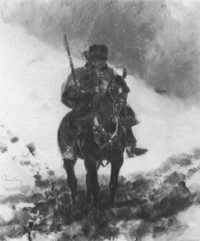 fig. 13
René Princeteau, Vélite de la garde, 1893-97, private collection (photograph courtesy of Galerie Schmit, Paris) 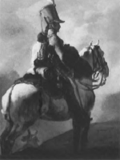 fig. 14
Théodore Géricault, Trompette des husards, n.d., Williamstown, Mass., Sterling and Francine Clark Art Institute | |
[pagina 160]
| |
 fig. 15
Théodore Géricault, Wounded cuirassier, 1814, Paris, Musée du Louvre (fig. 16). The former was conceived as a pendant to the more obviously dramatic Charging light cavalryman of 1812 (Paris, Musée du Louvre) and both differ in many respects from all previous military paintings. Unlike earlier battle scenes, both Géricault's works invest the anonymous and isolated modern soldier with the potential for heroism; for the first time, as Thomas Crow has written, the individual figure ‘is made to do the meaningful work normally reserved for the complex internal narratives of Classical history painting.’Ga naar voetnoot48 Princeteau returned to this interpretation, which had had little consequence for the battle paintings of the intervening period. Perhaps because he himself did not participate in the fighting, and as a result had no opportunity to make the detailed studies which characterise the pictures of Detaille and Neuville, Princeteau's images have a certain awkwardness and abstraction which might also be compared with Géricault. In both cases, deficiencies in drawing and composition are compensated by emotional tension and the bravura handling of paint, particularly in Princeteau's treatment of the snow. In Géricault's painting, although we do not see it, everything tells us that the wounded soldier is in mortal danger as he leaves the battlefield and this gives the canvas an added narrative element which is meant to draw the viewer in. This same strategy is employed by Princeteau: although it is still invisible, there is a sense of danger here, as the drawn pistol and the horse's ears clearly indicate. It is also perhaps possible to see in both figures symbols of an | |
[pagina 161]
| |
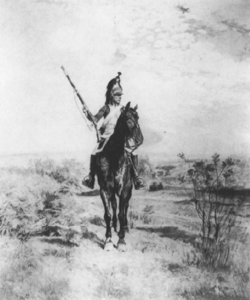 fig. 16
Ernest Meissonier, The outpost, 1880, The Art Institute of Chicago heroic nation in defeat, which would be equally appropriate to the year 1814 and to the post-Franco-Prussian War period. Meissonier's Outpost, although completely different in feeling, is so similar in composition that one almost needs to ask if it did not in fact serve as a direct inspiration.Ga naar voetnoot49 The mounted cavalryman, a member of the Napoleonic army, is depicted atop a grassy hill, overlooking a valley which stretches out below him. He has apparently just spied some kind of activity in the distance to the left, for both he and the horse gaze attentively in this direction. Like Princeteau's dragoon he has his rifle ready for action, and the horse seems to be listening for suspicious noises. Meissonier's painting, however, is far more literal than Princeteau's. His interest, as always, was in the accurate reproduction of historical detail. Horse and rider are placed at a distance from the viewer: we are meant to admire the artist's skill and objectivity, not to suffer with the man depicted. Although both riders are clearly confident in their own abilities we fear an approaching tragedy in the Princeteau, whereas in the Meissonier there is no emotion at all. His is simply a man performing his duty, while Princeteau's is this and also, as we have seen here and in so many other images of the period, a symbol of something greater and potentially healing. Interestingly, the work was not exhibited at the Salon. Instead, during the 1880s the artist seems to have concentrated primarily on more cheerful and less political subjects, for example scenes with farm animals, four of which were shown at the Salon (1883-86). An exception was Leading the charge of 1887 (present location unknown),Ga naar voetnoot50 which depicts a cavalry charge very much in the manner of Edouard Detaille's En batterie! (Paris, Musée de l'Armée). In the 1890s, however, Princeteau returned once again to military themes, painting two copies of The sentinel (1893 and 1897), Velite de la garde (fig. 13), and The trumpeter (fig. 17). Of these later works one, Before the attack (fig. 18), was given the subtitle ‘épisode de la | |
[pagina 162]
| |
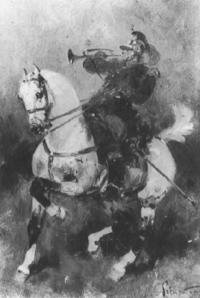 fig 17
René Princeteau, The trumpeter, 1895, private collection (photograph courtesy of Galerie Schmit, Paris) guerre de 1870.’ Although still a popular theme for both artists and writers, the Franco-Prussian War had been over for several decades at the time of its execution, so that the painter must have thought it necessary to give his audience a key to the subject matter. The scene depicts a strategic discussion before a cavalry charge and once again brings to mind a work by Meissonier, namely Moreau and Dessoles before Hohenlinden (1876, Dublin, National Gallery of Ireland), depicting an event from the Napoleonic Wars. Executed in a loose impasto technique that blurs the individual features of both the protagonists and the landscape, Princeteau's painting once again seeks to capture the mood rather than the precise historical detail of the event. Still more abstract and almost Courbet-like in its use of the palette knife, Cavalry in the snow (fig. 19) exudes the same air of mystery, chilly silence and uncertainty as, for example, Edouard Detaille's Coup-de-main (Musée du Dunkerque). 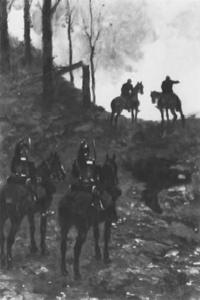 fig. 18
René Princeteau, Before the attack, 1893-97, private collection (photograph courtesy of Galerie Schmit, Paris) These were Princeteau's last paintings in this genre. In the later 1890s and for the rest of his career he painted only those subjects for which he had become known among his upper-class patrons - the racetrack, the stable and the hunt. At the Salon he exhibited pictures with titles such as Préparations du départ, Dechargement du foin, Neuf heures du matin and La semaille (all present location unknown), works with pastoral and, above all, purely peaceable themes.
Although by no means the most powerful work in its genre, Princeteau's Dragoon is a highly personal and therefore interesting interpretation of a popular theme. Particularly with regard to technique, it exhibits a certain independence and unconventionality which was certainly appealing to his student Toulouse-Lautrec and remains so for us today. | |
[pagina 163]
| |
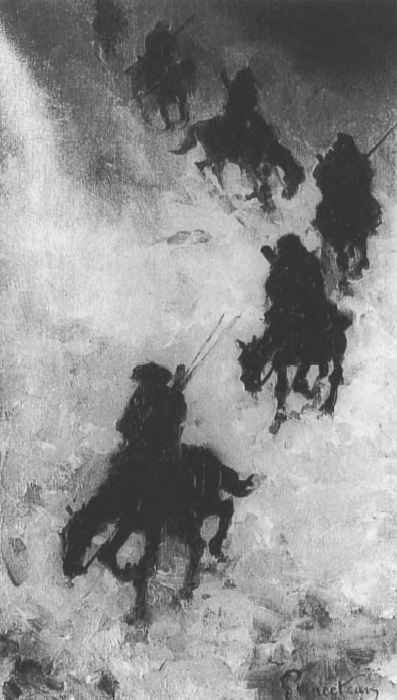 fig. 19
René Princeteau, Cavalry in the snow, 1893-97, private collection (photograph courtesy of Galerie Schmit, Paris) |
|

